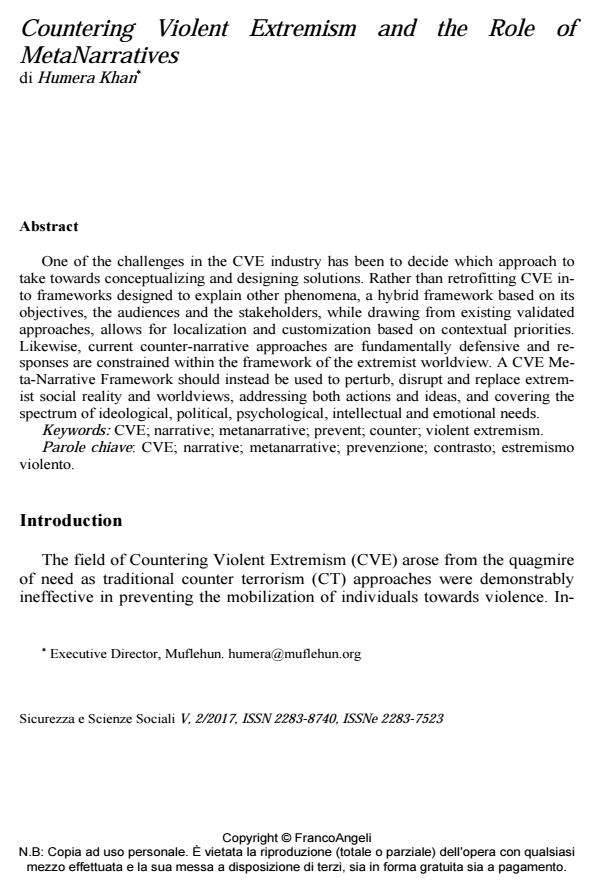Countering Violent Extremism and the Role of MetaNarratives
Titolo Rivista SICUREZZA E SCIENZE SOCIALI
Autori/Curatori Humera Khan
Anno di pubblicazione 2017 Fascicolo 2017/2 Lingua Italiano
Numero pagine 20 P. 159-178 Dimensione file 205 KB
DOI 10.3280/SISS2017-002010
Il DOI è il codice a barre della proprietà intellettuale: per saperne di più
clicca qui
Qui sotto puoi vedere in anteprima la prima pagina di questo articolo.
Se questo articolo ti interessa, lo puoi acquistare (e scaricare in formato pdf) seguendo le facili indicazioni per acquistare il download credit. Acquista Download Credits per scaricare questo Articolo in formato PDF

FrancoAngeli è membro della Publishers International Linking Association, Inc (PILA)associazione indipendente e non profit per facilitare (attraverso i servizi tecnologici implementati da CrossRef.org) l’accesso degli studiosi ai contenuti digitali nelle pubblicazioni professionali e scientifiche
;
Keywords:CVE; narrative; metanarrative; prevenzione; contrasto; estremismo violento.
- Abbas H. (2013). How Drones Create More Terrorists. August 23. https://www.theatlantic.com/international/archive/2013/08/how-drones-create-more-terrorists/278743/.
- Atran S. (2016). The Devoted Actor: Unconditional Commitment and Intractable Conflict across Cultures. Current Anthropology Volume, 57, Supplement 13: 192-S203. DOI: 10.1086/685495
- Bal M. (2009). Narratology: Introduction to the Theory of Narrative. Toronto: University of Toronto Press.
- Berger J. (2016). Contagious: Why Things Catch On. New York: 1st Simon & Schuster Paperbacks.
- Bertelsen P. (2015). Danish Preventive Measures and De-radicalization Strategies: The Aarhus Model. Panorama, 1: 241-253.
- Betz D. (2008). The Virtual Dimension of Insurgency and Counterinsurgency. Small Wars & Insurgencies, 19 (4): 510-540. DOI: 10.1080/09592310802462273
- Beutel A.J., Weine S., Saaed A., Mihajlovic A., Stone A., Beahrs J. and Shanfield S. (2016). Field Principles for Countering and Displacing Extremist Narratives. Journal of Terrorism Research (The Centre for the Study of Terrorism and Political Violence), 7 (3): 35-49.
- Brown L. (2016). State Dept.: U.S. Should ‘Rehabilitate’ and ‘Reintegrate’ Foreign Fighters Back into Society. September 8. Accessed March 12, 2017. http://www.cnsnews.com/news/article/lauretta-brown/state-dept-director-countering-violent-extremism-us-should-rehabilitate.
- Campbell J. (2008). The Hero with a Thousand Faces (The Collected Works of Joseph Campbell). Novato: New World Library.
- Cialdini R.B. (2007). Influence: the psychology of persuasion. New York: Collins.
- Corman S. R. and Dooley K.J. (2008). Strategic Communication on a Rugged Landscape-Principles for Finding the Right Message. COMOPS Journal. Consortium for Strategic Communication – Arizona State University, #0801.
- Corman S.R., Trethewey A. and Goodall B. (2007). A 21st Century Model for Communication in the Global War of Ideas- From Simplistic Influence to Pragmatic Complexity. COMOPS Journal. Consortium for Strategic Communication – Arizona State University. #0701.
- Fink N.C., and Barclay J. (2013). Mastering the Narrative- Counterterrorism Strategic Communication and the United Nations. Center on Global Counterterrorism Cooperation.
- Garagozov R. (2012). Narratives in conflict: A perspective. Dynamics of Asymmetric Conflict: Pathways toward terrorism and genocide, 5 (2): 101-106.
- Halverson J.R., Corman S.R. and Goodall H.I. (2011). Master Narratives of Islamist Extremism. New York: Palgrave Macmillan.
- Hedayah and International Centre for Counter-Terorism, The Hague. (2014). Developing Effective Counter-Narrative Frameworks for Countering Violent Extremism. Meeting Note.
- Horgan J. (2014). The Psychology of Terrorism. New York: Routledge.
- Institute for Strategic Dialogue. (2016). Best Practice Guide Content Creation. Counter Narratives Toolkit. www.counternarratives.org.
- Institute for Strategic Dialogue. (2016). Best Practice Guide Planning a Campaign. Counter Narrative Toolkit. www.counternarratives.org.
- Khan H. (2015). Why Countering Extremism Fails. February 18. https://www.foreignaffairs.com/articles/united-states/2015-02-18/why-countering-extremism-fails.
- Klein G., Moon B. and Hoffman R.R. (2006). Making Sense of Sensemaking 1: Alternative Perspectives. Intelligent Systems, IEEE, July/August: 70-73.
- Klein G., Moon B. and Hoffman R.R. (2006). Making Sense of Sensemaking 2: A Macrocognitive Model. Intelligent Systems, IEEE, October: 88-92. DOI: 10.1109/MIS.2006.100
- Kruglanski A., Gelfand M., Belanger J., Sheveland A., Hetiarachchi M. and Gunaratna R. (2014). The Psychology of Radicalization and Deradicalization: How Significance Quest Impacts Violent Extremism. Advances in Political Psychology, 35, Suppl. 1: 69-93.
- Lakoff G. (2014). The ALL NEW Don't Think of an Elephant!: Know Your Values and Frame the Debate. White River Junction: Chelsea Green Publishing.
- Lakoff G. and Johnson M. (2003). Metaphor We Live By. Chicago: University of Chicago Press.
- Maslow A.H. (1966). The psychology of science; a reconnaissance. New York: Harper and Row.
- McCauley C. and Moskalenko S. (2011). Friction: How Radicalization Happens to Them and Us. New York: Oxford University Press.
- McCauley C. and Moskalenko S. (2014). Toward a Profile of Lone Wolf Terrorists: What Moves an Individual From Radical Opinion to Radical Action. Terrorism And Political Violence, 26 (1): 69-85.
- Moghaddam F.M. (2005). The Staircase to Terrorism A Psychological Exploration. American Psychologist (American Psychological Association), 60 (2): 161-169. DOI: 10.1037/0003-066X.60.2.161
- Moghaddam, F.M. (2010). De-Radicalization and the Staircase from Terrorism. In Canter D. (ed.) The Faces of Terrorism: Multidisciplinary Perspectives. Oxford, UK: Wiley-Blackwell. DOI: 10.1002/9780470744499
- Muflehun. (2012). www.muflehun.org.
- National Security Critical Issues Task Force. (2016). Countering Violent Extremism – Applying the Public Health Approach. Center for Security Studies, Georgetown University, Washington, DC: Georgetown Security Studies Review.
- Ritzmann, A., interview by Club de Madrid. (2017). Alexander Ritzmann: “Focus on hard measures might even have fostered radicalization” (February 10). http://stoppingviolentextremism.org/qa-with-alex-ritzmann.
- Romaniuk P. (2015). Does CVE Work? Lessons Learned from the Global Effort to Counter Violent Extremism. Global Center on Cooperative Security.
- Russell J, and Haras R. (2016). Countering Islamist Extremist Narratives: A Strategic Briefing. Quilliam.
- Samuel T.K. (2012). Reaching the Youth: Countering the Terrorist Narrative. Perpustakaan Negara Malaysia.
- Silber M.D., and Arvin B. (2007). Radicalization in the West: The Homegrown Threat. New York: NYPD Intelligence Division.
- The Soufan Group and Qatar International Academy for Security Studies. (2013). Countering Violent Extremism- The Counter Narrative Study. QIASS.
- Translation by Federation of American Scientists. 2005. Letter from Ayman al Zawahiri to Abu Musab al Zarqawi. https://fas.org/irp/news/2005/10/letter_in_english.pdf.
- White House National Security Council. (2015). US National Security Startegy. Washington, DC: White House.
Humera Khan, Countering Violent Extremism and the Role of MetaNarratives in "SICUREZZA E SCIENZE SOCIALI" 2/2017, pp 159-178, DOI: 10.3280/SISS2017-002010